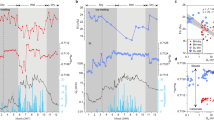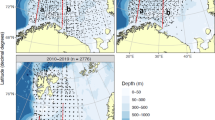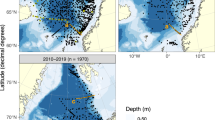Abstract
A basic approach used in estuarine chemistry is to determine the experimental distribution of one given element with chlorinity and compare it with that predicted from the simple mixing of river water with seawater. This method provides useful results but several practical problems arise—including the definition of correct end-members, the role of input of tributaries or bank flow in the saline part of the estuary, and the occurrence of several water masses of different ages along the estuary. In addition, this method is not applicable in those areas of constant density which can be of prime importance in estuarine geochemistry and dynamic understanding. To characterise these various problems it is worthwhile to use a suitable freshwater tracer such as tritium1, D/H or the 18O/16O isotopic ratio. The oxygen isotope ratio has been used successfully to study river water mixing2 but has been little used in estuaries. The basic principle of this method is that the isotopic composition of river water might vary with time, and that different rivers might have different isotopic composition whereas ocean water is of fairly uniform composition. We present here a study of oxygen isotope composition in various estuaries, ranging (in Pritchard's classification3) from the saltwedge type such as Rhône (France) and Zaire (Congo), to a partially mixed type such as Gironde, Loire and Charente (France) and Godavari (India). These estuaries cover a wide variety of hydroclimatological conditions including the temperate and tropical regimes.
This is a preview of subscription content, access via your institution
Access options
Subscribe to this journal
Receive 51 print issues and online access
$199.00 per year
only $3.90 per issue
Buy this article
- Purchase on Springer Link
- Instant access to full article PDF
Prices may be subject to local taxes which are calculated during checkout
Similar content being viewed by others
References
Meybeck, M., Hubert, P., Martin, J.-M., Olive, Ph. in Isotope Hydrology, 523 (IAEA, Vienna, 1970).
Krouse, H. R. & Ross Mackay, J. Can. J. Earth Sci. 8, 1107–1109 (1971).
Pritchard, D. W. Proc. Am. Soc. Civil Engng 81, 711 (1955).
Epstein, S. & Mayeda, T. Geochim. cosmochim. Acta 4, 213–214 (1953).
Duplessy, J.-C. thesis, Univ. Paris (1972).
Riley, J.-P. & Skirrow, G. Chemical Oceanography Vol. 1 (Academic, London, 1965).
Craig, H. & Gordon, L. J. Stable Isotopes in Oceanographic Studies, 9–130 (CNR, Spoleto, 1965).
Duplessy, J.-C. C.r. hebd Séanc. Acad. Sci. Paris 271, 1075–1078 (1970).
IAEA-Environmental Isotope Data no. 5: World Survey of Isotope Concentration in Precipitation (IAEA, Vienna).
Blavoux, B. thesis, Univ. Paris (1978).
Dansgaard, W. Tellus 1, 435–468 (1964).
Salvadori, F. thesis, Univ. Paris (1976).
Author information
Authors and Affiliations
Rights and permissions
About this article
Cite this article
Martin, J., Letolle, R. Oxygen 18 in estuaries. Nature 282, 292–294 (1979). https://doi.org/10.1038/282292a0
Received:
Accepted:
Issue Date:
DOI: https://doi.org/10.1038/282292a0
This article is cited by
-
Characterization of the water chemistry, sediment 13C and 18O compositions of Kolleru Lake—a Ramsar wetland in Andhra Pradesh, India
Environmental Monitoring and Assessment (2016)
-
18O modelling of freshwater inputs in Baffin Bay and Canadian Arctic coastal waters
Nature (1981)
Comments
By submitting a comment you agree to abide by our Terms and Community Guidelines. If you find something abusive or that does not comply with our terms or guidelines please flag it as inappropriate.



